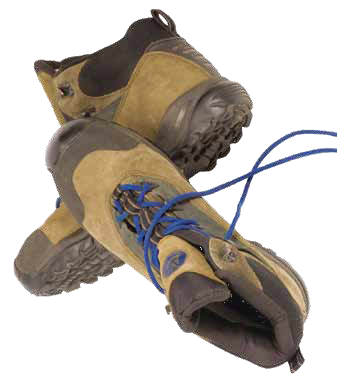| Your Feet  Footgear Footgear If your feet feel good, chances are you’ll have a great time hiking. Taking care of your feet begins with choosing what to wear. Almost any shoes are fine for short walks over easy ground. For longer hikes in good weather, lightweight boots usually work well. Leather shoes and boots were once the only choices for Scouts. Leather hiking boots are still popular today and can give your feet and ankles plenty of protection and support. They will also keep snow and rain from soaking your socks. They are a good choice if you will be hiking and backpacking on rugged trails. Choose carefully when selecting leather boots, though. Stiff boots for mountaineering or serious winter travel can be quite heavy and are better suited for more experienced hikers. Many styles of modern outdoor footwear are made of nylon mesh and other manufactured materials. Most of these boots are lightweight and sturdy. They could be just what you need for the trail. The footwear you choose must fit well. If you shop for a new pair of boots or hiking shoes, try them on while wearing the same socks you will use on the trail. Your heels should not slip much when you walk, and your toes should have a little wiggle room. Before using your new hiking shoes or boots on a hike, wear them around home for a few days until they adjust to the shape of your feet. Caring for Hiking Boots Hiking boots will last a long time if you take care of them. When you get home from a trip, remove mud or soil from your boots with a stiff brush or by hosing them off. Allow them to dry at room temperature. (High heat can melt nylon and harm leather, so don’t put your boots too close to a fire.) Treat leather with a boot dressing meant for outdoor footwear. Oils and waxes in the dressing will keep leather flexible and help the boots repel water. Camp Shoes Many campers and backpackers carry a pair of lightweight shoes in their packs so that they can get out of their boots at the end of the day. Choose closed-toe shoes that will help protect you from injury. A pair of running shoes might be just right. Water shoes can work well, too, if they are also comfortable for walking about on dry land. Your extra shoes will come in handy when you need to wade across a stream. Take off your hiking boots and socks and change into your extra shoes to cross the water. Socks Hiking socks made of wool or a wool-nylon blend will help cushion your feet as you walk. Try wearing a pair of thin, synthetic-blend socks underneath your hiking socks. The inner socks will slide against the heavier outer socks and wick moisture from the skin. This will reduce friction and your chances of getting blisters. Carry spare socks on your hikes. If your feet get tired, change into fresh socks and hang the damp ones on your pack to dry. |